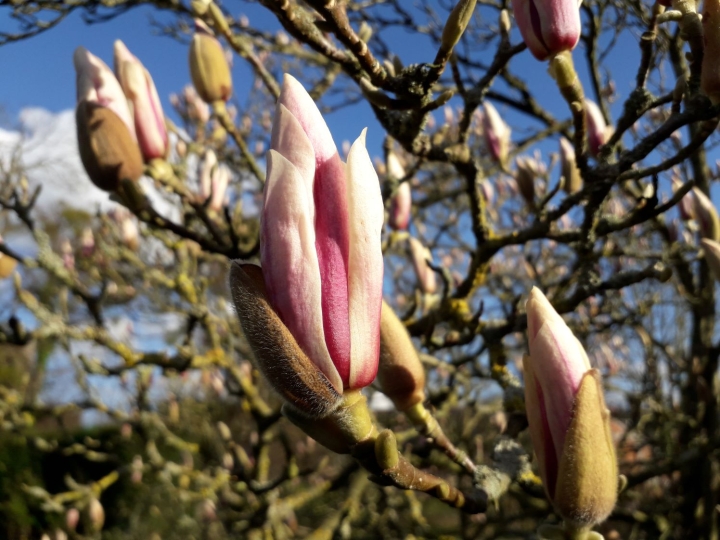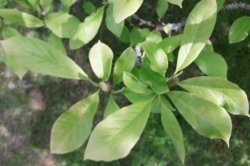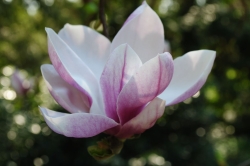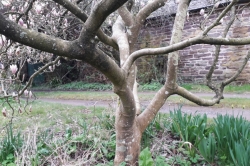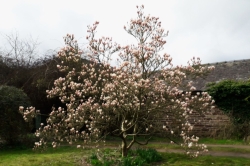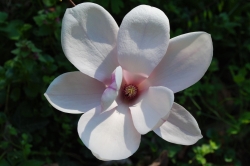Magnolias are an ancient species of flowering plant – fossilized specimens of Magnoliaceae have been dated back to 95 million years ago! Non-native to the UK, these flamboyantly floriferous shrubs and trees are always planted here as an ornamental, most usually in gardens, parks and country estates. As well as being beautiful and fragrant, the blossoms can be eaten and can have a surprisingly spicy flavour, not unlike ginger.
Home / Hedgerow Guide /
Magnolia
Magnolia
| Hedgerow Type | |
| Common Names | Magnolia |
| Scientific Name | Magnolia spp. |
| Season Start | Mar |
| Season End | Sep |
Leaves
In deciduous Magnolias, the leaves appear in late Spring, well after the early flowers have emerged onto bare branches. In the evergreen Magnolia species, the leaves stay all your round, with the flowers appearing amongst the foliage, over the Summer months.
Evergreen Magnolia leaves are usually large, ovate and leathery, with dark green, glossy upper surfaces and a rusty-brown, matt under-surface.
Deciduous Magnolia leaves are similar in shape, but generally smaller and less leathery and with more noticeable veins.
Flowers
Magnolias are renowned for their stunning floral displays, all the more noticeable as most appear in Spring, before the leaves grow and hide them. The individual flowers appear on short spurs along the twigs and branches. They can be cup or goblet-shaped, or star-like. They’re most often pink, white, purplish or cream coloured, but can also be yellow.
The unopened flower buds are enclosed within a protective velvety, brownish-green bract, (rather than the usual sepals). The ‘petals’ are actually ‘tepals’ – a structure thought to be indicative of ancient plants.
Deciduous Magnolias mostly flower in March – April, whereas the evergreen Magnolias flower in mid-late Summer.
Fruit
Cone-like fruits are often produced in the Summer through to Autumn.
Trunk
Many Magnolias grow slowly and remain shrub-sized, but some branch upwards to form large specimen trees, up to 40 metres tall.
The bark is usually smooth and greyish brown in colour.
Smell
Many of the Magnolia blossoms are fragrant, with a rich vanilla scent. M. grandiflora smells like lemon meringue pie!
Taste
We like to recommend the flowers, which as well as being a joy to look at, are also good to eat. The taste can vary from tree to tree. In our experience, the lighter coloured flowers tend to be sweeter and the darker ones more gingery. The petals can be used fresh as flavouring, garnish or in salads – savoury or sweet fruity ones. They are also sometimes dried to make a tea infusion. The whole flower buds can be pickled in sweet vinegar; great with cheeses or to flavour rice dishes. Young leaves and flowers can also be steamed, stir-fried etc as a vegetable, particularly for Oriental dishes. If the tree is growing in somebody else’s garden, be sure to ask the owner’s permission before you pick!
Medicinal Uses
Magnolia bark, flowers and buds have traditionally been used in Chinese and Japanese medicine for treating digestive disorders, anxiety, headache and depression.
Other Facts
Because the Magnoliaceae plant family is so ancient, it has had to survive many world-changing geological events, such as continental drift, volcanic activity and ice ages!
The natural range of Magnolias is Asia, the Americas and the West Indies. Magnolias are the official bloom of Mississippi, Louisiana, Shanghai, North Korea and Gangnam!
Magnolias evolved before bees – so many of them are actually pollinated by beetles.
As well as the native species, there are many ornamental cultivars. Most commonly seen species in the UK are M. soulangeana, M. stellata and M. grandiflora.


